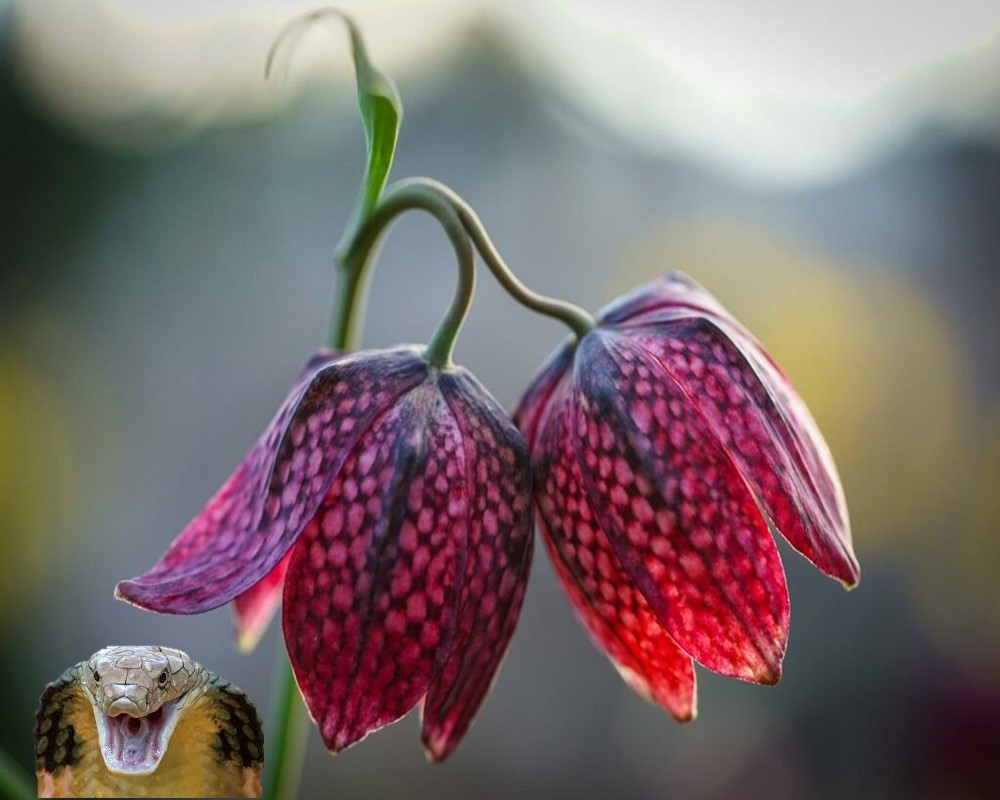The Cobra Lily (Arisaema consanguineum) is an irresistible plant that looks like a snake head; However, the Snake’s Head Fritillary and Meadow Sage flowers are also similar to a snake plant. The Snake Plant (Dracaena trifasciata) leaves resemble a snake Skin. Please keep reading to learn more about these stunning plants and see their strange images.
The Plant Looks Like a Snake Head
Meadow Sage
Scientific Name: Salvia pratensis

Meadow Sage flowers are very similar to a snake head. It is also known as Balkan clary, Meadow sage, Violet sage, Woodland sage, Blue sage, and Wild sage.
Appearance:
- Height: Generally reaches 1-2 feet (30-60 cm) tall.
- Stems: Square-shaped and often covered in soft hairs.
- Leaves: Wrinkled, toothed, and often covered in fuzz. They are typically arranged in opposite pairs.
- Flowers: Vibrant purple or blue flowers, sometimes with white or pink variations. They are arranged in whorls around the stems and have a distinctive two-lipped shape.
- Fruit: Small, dry fruits that contain numerous seeds.
Habitat:
- Meadows: As the common name suggests, meadow sage thrives in meadows and grasslands.
- Pastures: It can also be found in pastures and other open, sunny areas.
- Roadsides: Often seen growing along roadsides and disturbed areas.
- Soil preference: Prefers well-drained soil with moderate fertility.
Meadow sage is a striking and adaptable wildflower that adds colour and beauty to meadows and other natural landscapes. Its vibrant flowers and distinctive appearance make it a popular choice for gardens and naturalized areas.
Snake’s Head Fritillary
Scientific Name: Fritillaria meleagris

This plant typically reaches around 12 inches (30 cm) tall. Its stem is slender and upright and its leaves are linear and lance-shaped, often with a glaucous (bluish-green) hue.
- Flowers: Pendulous, bell-shaped flowers that are usually checkered with purple or brown markings on a white or pale green background. They are often referred to as “snake’s heads” due to their shape and colouration.
- Fruit: Capsules containing numerous seeds.
Habitat:
- Meadows: Snake’s head fritillaries thrive in damp, nutrient-rich meadows.
- Pastures: They can also be found in pastures and other open, grassy areas.
- Woodland edges: Sometimes found growing in the fringes of woodlands.
- Soil preference: Prefers moist, well-drained soil.
Snake’s head fritillaries are a protected species in many areas and should not be disturbed or collected. They are best enjoyed in their natural habitat.
The Cobra Lily
Scientific Name: Arisaema consanguineum

It is a striking and unique plant that gets its name from its resemblance to a cobra raising its hood. The Cobra Lily (Arisaema consanguineum) is a native plant of East Asia, specifically found in regions with temperate climates. Its preferred habitat includes:
Moist, shady forests: Cobra Lilies thrive in areas with high humidity and ample shade, such as deciduous woodlands and bamboo forests.
Rich, well-drained soil: They require soil that is rich in organic matter and has good drainage.
Humus-rich forest floor: The forest floor is often covered in a layer of humus, which provides essential nutrients for the Cobra Lily.
In its natural habitat, the Cobra Lily can be found growing in clusters or colonies, often in association with other woodland plants.
How to Identify Cobra Lily (The Plant Looks Like a Snake Head)
In the following, you can find some key features which help you to identify Arisaema consanguineum
Stem and Leaves:
- Tall and slender: The stem of the Cobra Lily can grow quite tall, often reaching heights of several feet.
- Single leaf: The plant typically has a single, large, compound leaf that is divided into several leaflets. These leaflets are often dark green with a glossy finish.
Flower:
- Spadix and spathe: The most distinctive feature of the Cobra Lily is its flower, which consists of a spadix (a fleshy stalk) and a spathe (a hood-like structure).
- Cobra-like appearance: The spathe curves upward, creating a cobra-like hood that shelters the spadix. The spadix itself is often a vibrant purple or maroon colour.
- Male and female flowers: The spadix can contain both male and female flowers, or it can be specialized for one sex.
Exotic and unusual:
The Cobra Lily has a truly exotic and unusual appearance that sets it apart from most other plants. Its unique flower structure and striking colour combination make it a popular choice for gardens and collections.
Tips for Growing Cobra Lily (Arisaema consanguineum)
You can grow Cobra Lilies indoors. They are well-suited to indoor cultivation, provided you can provide them with the right conditions:
- Bright, indirect light: While they prefer shade in their natural habitat, indoor Cobra Lilies need bright, indirect light. Avoid direct sunlight, as it can burn the leaves.
- Warm temperatures: They thrive in warm temperatures, ideally between 65-80°F (18-27°C).
- High humidity: Cobra Lilies require high humidity levels. You can increase humidity by using a humidifier, misting the plant regularly, or placing it on a pebble tray filled with water.
- Well-draining potting mix: Use a potting mix that is rich in organic matter and well-draining. A mix of peat moss, perlite, and orchid bark is a good option.
- Regular watering: Keep the soil consistently moist but not soggy. Allow the top inch of soil to dry out slightly between waterings.
Be Caution about Growing Arisaema consanguineum Indoors
Cobra Lily is toxic to cats. If ingested, they can cause severe gastrointestinal upset, including vomiting, diarrhoea, and abdominal pain. So, it is important to keep Cobra Lilies out of reach of cats and other pets. If you suspect that your cat has ingested any part of a Cobra Lily, contact your veterinarian immediately.
The Plant Looks Like a Snake Tongue

The Snake Plant (Dracaena trifasciata / Sansevieria trifasciata) gets its name from its long, sword-like leaves that resemble snakes. These leaves are typically dark green with lighter green or yellow stripes running horizontally across them. They are thick and succulent and can grow quite tall, often reaching heights of several feet.
The Snake Plant is also known by several other names, including:
- Mother-in-Law’s Tongue: This is a common nickname for the Snake Plant, perhaps due to its tough, sword-like leaves.
- Saint George’s Sword: This is another nickname for the Snake Plant, referring to its resemblance to a sword.
- Viper’s Bowstring Hemp: This is a less common name for the Snake Plant, referring to its strong fibres that were once used to make bowstrings.
Some varieties of Snake Plants have variegated leaves with different patterns or colours, such as white, silver, or golden yellow. Others may have curly or twisted leaves.
Snake Plants are native to Africa and Madagascar. They are well-adapted to arid and semi-arid environments and can grow in rocky, sandy soils. In their natural habitat, Snake Plants often grow in full sun or partial shade. They are drought-tolerant and can survive long periods without water.
The Snake Plant is also a popular houseplant that is a striking and low-maintenance indoor plant that adds a touch of greenery to any room. Its unique appearance and adaptability make it a popular choice among plant enthusiasts.
Tips for Caring for Snake Plants Indoors
Snake Plants are incredibly low-maintenance houseplants that are easy to care for. Here are some tips for growing Snake Plants indoors:
- Light: Snake Plants can tolerate a wide range of light conditions, from bright, and indirect light to low light. However, they prefer bright, indirect light for optimal growth.
- Watering: Snake Plants are drought-tolerant and can survive long periods without water. Allow the soil to dry out completely between waterings. Overwatering is the most common cause of problems with Snake Plants.
- Soil: Use a well-draining potting mix, such as a cactus or succulent mix.
- Temperature: Snake Plants can tolerate a wide range of temperatures, but they prefer temperatures between 65-85°F (18-29°C).
- Humidity: Snake Plants are tolerant of low humidity and can thrive in dry environments.
- Fertilizer: Fertilize Snake Plants once a year during the growing season (spring and summer) with a balanced houseplant fertilizer.
- Repotting: Repot Snake Plants every 2-3 years or when the roots become pot-bound.
Conclusion
The Cobra Lily (Arisaema consanguineum) Snake’s Head Fritillary and Meadow Sage produce flowers which are very similar to a snake head. However, The Snake Plants (Dracaena trifasciata) are also similar to a snake Skin with its variegate long leaves.
D

Elahe Rabiei
Hi, I’m Elaheh. My Academic major is plant protection, and houseplants are my expertise. As a houseplant lover, my house is full of indoor plants and it is my passion to take care of them. Hence, I’m here to share my knowledge and experience about growing healthy houseplants. I am also a plant protection advisor, so feel free to ask me any questions you may have.

